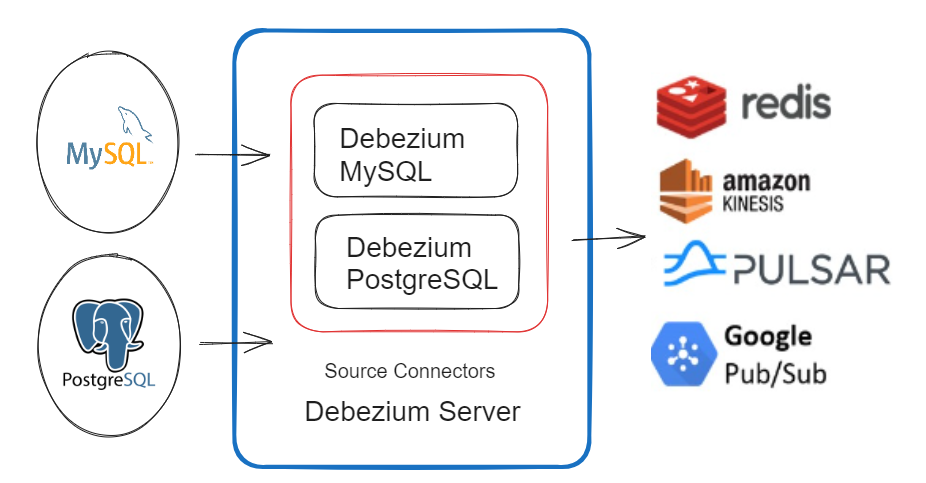Explore our expert-made templates & start with the right one for you.
Understanding Debezium Outbox Pattern
If your focus is on Debezium, we’ve crafted an in-depth technical resource titled “Debezium for CDC: Benefits, Pitfalls, and Alternatives.” This detailed guide review the foundational aspects of Debezium, examining its strengths and drawbacks, and providing insights into creating scalable CDC pipelines with reduced engineering complexity. Access this valuable guide at no cost by downloading it from here.
At its core, the Outbox Pattern is a design approach used in microservices architectures to ensure reliable data management and event propagation. In a typical microservices setup, each service has its own database, leading to challenges in maintaining data consistency across different services. The Outbox Pattern addresses this issue by introducing an “outbox” table in the service’s database.
Whenever a service performs a data change that other services need to know about, it writes a record of this event into the outbox table. This record includes all the necessary information that other services might need. The primary goal here is to ensure that the data change and the event record are written in the same database transaction. This approach provides atomicity, ensuring that either both the change and the event record are successfully written, or neither is, which helps in maintaining data consistency.

Integration with Debezium
Debezium, a popular open-source tool for change data capture (CDC), comes into play by monitoring the outbox table. When Debezium detects a new entry in this table, it captures the event and streams it to a message broker like Apache Kafka. This way, other services can consume these events reliably and in the order they were created.
Debezium’s role is crucial as it provides the bridge between the database transaction and the asynchronous world of event-driven architectures. It ensures that events are only captured if the transaction that created them is successfully committed, thereby preventing any loss of data or inconsistent states.
Benefits for Data Synchronization and Integrity
The Debezium Outbox Pattern offers several significant benefits for data synchronization and integrity in a distributed system:
- Transactional Integrity: By ensuring that database changes and event emissions are part of the same transaction, the pattern maintains strict consistency between the state of the service’s database and the events it produces.
- Reliable Event Ordering: Debezium guarantees the order of events as they are captured in the sequence they were committed to the database. This ordering is crucial for maintaining data consistency across microservices.
- Scalability and Performance: The pattern scales well as it decouples event production from consumption. Services can produce events at their own pace, while consumers process them asynchronously.
- Fault Tolerance: In case of failures, Debezium ensures that events are not lost and can be replayed. This resilience is key in distributed systems where service interruptions are common.
- Flexibility in Event Consumption: Different microservices can consume the events as per their requirements, either in real-time or in batches, providing flexibility in handling these events.

Common Challenges in Implementing the Outbox Pattern with Debezium
- Schema Design Complexity: Designing the outbox table schema can be complex, especially in determining what data to include in the event records to ensure all necessary information is available for downstream services.
- Transaction Overhead: The requirement to write to the outbox table within the same transaction as the business operation can introduce additional overhead, especially in high-throughput scenarios.
- Event Schema Evolution: Managing changes to the event schema over time without disrupting downstream services can be challenging. It requires careful planning and coordination.
- Duplicate Event Handling: While Debezium ensures reliable event delivery, consumers must be idempotent – capable of handling duplicate events without adverse effects.
- Ordering Guarantees: Ensuring strict order of event processing can be complex in distributed systems, especially when dealing with network latencies and various processing speeds of consumer services.
Performance Considerations and Addressing Them
- Optimizing Database Transactions: Minimize the transaction time by ensuring that the logic for writing to the outbox table is efficient. Use batch processing where applicable.
- Load Balancing: Distribute the load effectively among multiple instances of the service and Debezium to prevent any single point of bottleneck.
- Monitoring and Tuning: Regularly monitor the performance and tune the database, Debezium configurations, and Kafka settings for optimal throughput and latency.
- Database Indexing: Proper indexing of the outbox table is essential to speed up the data retrieval by Debezium.
- Asynchronous Processing: Implement asynchronous processing patterns in consumer services to handle the events efficiently without blocking operations.
Wrapping up
The Debezium Outbox Pattern presents a strategic solution to the challenges of data management and synchronization in microservices architectures. By leveraging the outbox table concept and integrating with Debezium for change data capture, this pattern ensures transactional integrity, reliable event ordering, and enhances overall system resilience. Although its implementation can be complex, involving considerations such as schema design, transaction overhead, and event schema evolution, the benefits it offers in terms of scalability, fault tolerance, and flexibility in event consumption make it a valuable approach. As such, the Debezium Outbox Pattern is increasingly being adopted by developers and architects in complex distributed systems, marking a significant step forward in ensuring data consistency and reliability in the ever-evolving landscape of software engineering.

